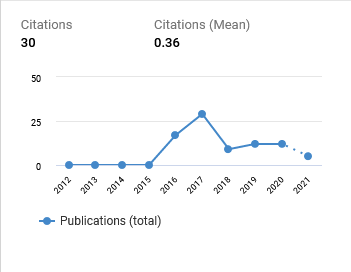Representation of Sense of Place on Instagram
Case of the Malioboro Traditional Shopping Corridor in Yogyakarta
DOI:
https://doi.org/10.29080/eija.v8i1.1423Keywords:
Instagram,, Tourism area, The Malioboro Corridor, Social Media, Place experienceAbstract
This research aimed to examine the representation of a sense of place for a traditional shopping place on social media, both in the form of visual and narrative media. The research object was the Malioboro shopping area as represented on social media posts. The theoretical contribution of this research is as a literature review on the representation of sense of place in the Malioboro shopping area, while the practical contribution of this research is as a reference for policymakers or the government in formulating the development policy of traditional shopping streets on social media. This research was qualitative in nature, with Instagram as the data source. All posts and videos with captions were analyzed to explore the Malioboro Corridor’s physical attributes, social activities, and shared meaning. In conclusion, the three dimensions of a sense of place regarding the local conditions were presented in Instagram content..
Downloads
References
Budiarti, F., & Mahadi, K. I. (2015). Strategi penataan kawasan Malioboro menjadi kawasan pedestrian. Planesa, 6(01), 212826.
Canter, D. (1977). The psychology of place. St Martin’S Press.
Chawla, L. (1992). Childhood Place Attachments. Place Attachment, 63–86. https://doi.org/10.1007/978-1-4684-8753-4_4
Dameria, C., Akbar, R., & Natalivan Indradjati, P. (2018). Whose Sense of Place? Re-thinking Place Concept and Urban Heritage Conservation in Social Media Era. IOP Conference Series: Earth and Environmental Science, 158(1). https://doi.org/10.1088/1755-1315/158/1/012010
Dani, A. R., & Wijono, D. (2017). Tipomorfologi Fasade Bangunan Pertokoan di Sepanjang Ruas Jalan Malioboro, Yogyakarta. Universitas Gadjah Mada.
Erkılıç, N. H., Özmen, E. D., & Taştan, H. (2021). Interpreting the Factors in Forming the Sense of Place: The Case of Kuzguncuk Neighbourhood, Istanbul. ICONARP International Journal of Architecture and Planning ISSN: 2147-9380, 9(1), 261–285.
Kusumowidagdo, A., Sachari, A., & Widodo, P. (2013). The Setting of Internal Shopping Centres’ Public Spaces and Their Relationship to the Visitor. GSTF Journal of Engineering Technology (JET), 2(1), 211–219. https://doi.org/10.5176/2251-3701_2.1.56
Kusumowidagdo, A., Sachari, A., & Widodo, P. (2015). Visitors’ Perception towards Public Space in Shopping Center in the Creation Sense of Place. Procedia - Social and Behavioral Sciences, 184(July), 266–272. https://doi.org/10.1016/j.sbspro.2015.05.090
Lynch, K. (1960). The image of the city (Vol. 11). MIT press.
Montgomery, J. (1998). Making a city: Urbanity, vitality and urban design. Journal of Urban Design, 3(1), 93–116.
Nisa, A. F., & Haryanto, R. (2014). Kajian Keberadaan Wisata Belanja Malioboro terhadap Pertumbuhan Jasa Akomodasi di Jalan Sosrowijayan dan Jalan Dagen. Teknik PWK (Perencanaan Wilayah Kota), 3(4), 933–948.
Özkul, D., & Humphreys, L. (2015). Record and remember: Memory and meaning-making practices through mobile media. Mobile Media and Communication, 3(3), 351–365. https://doi.org/10.1177/2050157914565846
PPS. (2013). What Makes a Successful Place?
Punter, J. (1991). Participation in the design of urban space. Landscape Design, 200(1), 24–27.
Purbadi, Y. D. (2005). Malioboro: Ruang Kota dalam Arus Dinamika Wacana-wacana.
Puren, K., Roos, V., & Coetzee, H. (2018). Sense of place: using people’s experiences in relation to a rural landscape to inform spatial planning guidelines. International Planning Studies, 23(1), 16–36.
Sasmito, A., & Sudarwani, M. M. (2013). Karakteristik Pertokoan Pinggir Jalan Malioboro. Dinamika Sains, 11(26).
Schulz, C. N. (1980). Genius loci: Towards a phenomenology of architecture. Academy Editions, London.
Seeburger, J., & Foth, M. (2012). Content sharing on public screens: Experiences through iterating social and spatial contexts. Proceedings of the 24th Australian Computer-Human Interaction Conference, 530–539.
Shelton, T., Poorthuis, A., & Zook, M. (2015). Social media and the city: Rethinking urban socio-spatial inequality using user-generated geographic information. Landscape and Urban Planning, 142, 198–211. https://doi.org/10.1016/j.landurbplan.2015.02.020
Smith, S. (2015). A sense of place: Place, culture and tourism. Tourism Recreation Research, 40(2), 220–233.
Ujang, N., Moulay, A., & Zakaria, J. (2018). Visitors’ Attachment to Historic Tourism Places in Kuala Lumpur City Centre towards Sustainable Urban Regeneration. Environment-Behaviour Proceedings Journal, 3(9), 165. https://doi.org/10.21834/e-bpj.v3i9.1521
Waxman, L. (2006). The Coffee Shop: Social and Physical factors Influencing Place Attachment. Interior Design, 31(3), 35–53.
Zacharias, J. (2016). Choosing a Path in the Underground: Visual Information and Preference. ACUUS 2002 International Conference URBAN UNDERGROUND SPACE: A RESOURCE FOR CITIES, (January 2002), 10. Retrieved from https://www.researchgate.net/publication/237560221_CHOOSING_A_PATH_IN_THE_UNDERGROUND_VISUAL_INFORMATION_AND_PREFERENCE?enrichId=rgreq-263cb4fe-d276-4067-b9e0-9fb2e220fb40&enrichSource=Y292ZXJQYWdlOzIzNzU2MDIyMTtBUzoxMDY1NjEwODcyMTM1NjlAMTQwMjQxNzU1MTE2NA

Downloads
Additional Files
Published
How to Cite
Issue
Section
Categories
License
Copyright (c) 2022 Melania Rahadiyanti, Astrid Kusumowidagdo

This work is licensed under a Creative Commons Attribution-ShareAlike 4.0 International License.
- Authors retain copyright and grant the journal right of first publication with the work simultaneously licensed under a Creative Commons Attribution ShareAlike License that allows others to share the work with an acknowledgment of the work's authorship and initial publication in this journal.
- Authors are able to enter into separate, additional contractual arrangements for the non-exclusive distribution of the journal's published version of the work (e.g., post it to an institutional repository or publish it in a book), with an acknowledgment of its initial publication in this journal.
- Authors are permitted and encouraged to post their work online (e.g., in institutional repositories, pre-print sites, or on their website) prior to and during the submission process, as it can lead to productive exchanges, as well as earlier and greater dissemination of published work.
































